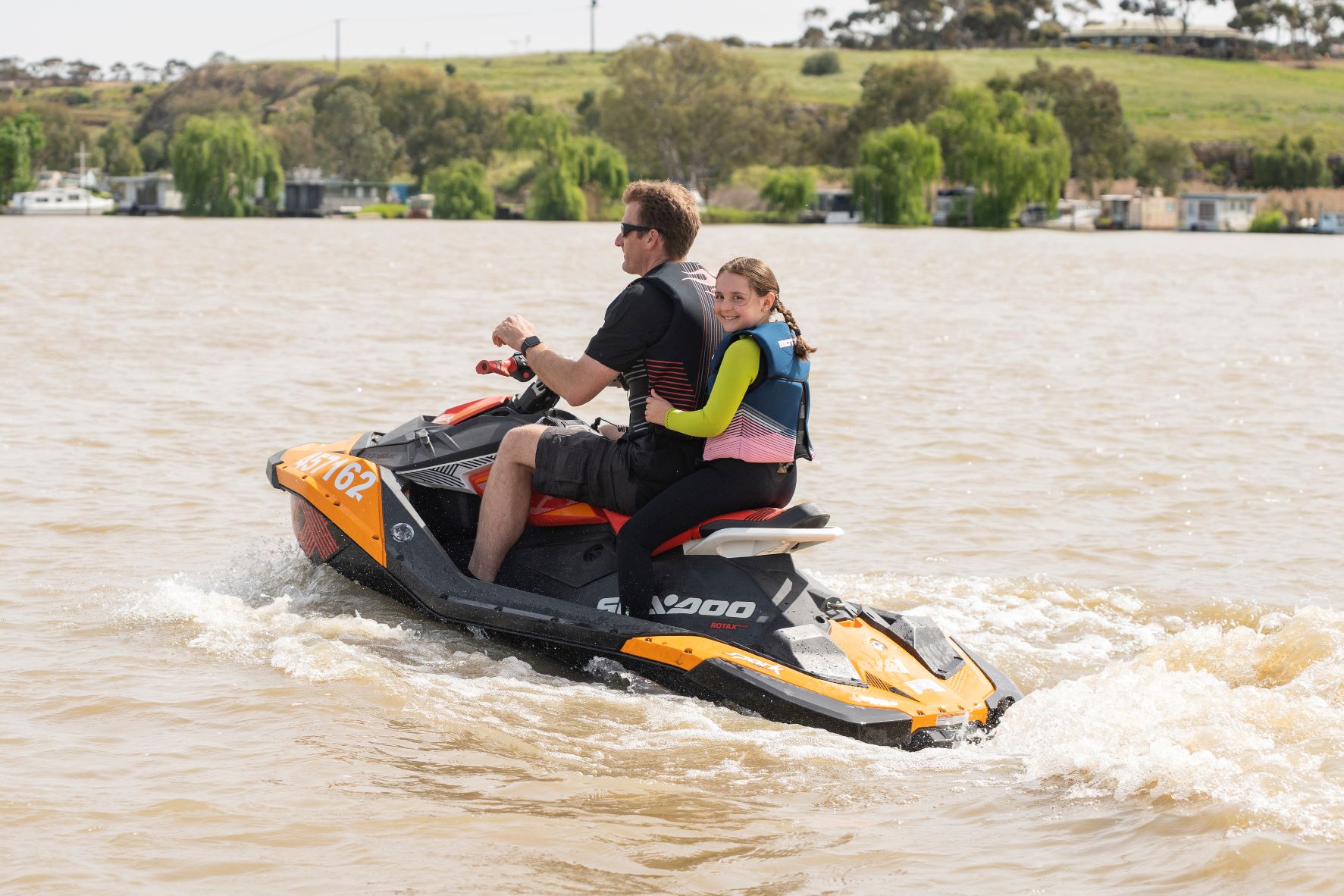Personal watercraft safety
A personal watercraft (PWC), also commonly known as a jet ski, is a vessel with a motor that has a fully enclosed hull. It is operated by a person who either sits, stands or kneels on it. It is designed to not retain water if capsized.
A PWC is powerful, fast and able to change course quickly, which makes it an exciting choice of craft for enjoying and experiencing our state's waterways.
They must be registered for use in South Australia. The following guidelines apply to affixing your registration number, which takes precedence over decorative or customised decals and striping. Your registration number must be:
- a different colour to the craft
- fixed on both sides
- a minimum of 100 mm high
- affixed to the hull above the waterline and clearly readable from 50 m in fine, clear conditions while the vessel is underway.

When personal watercraft can be operated
A personal watercraft (PWC) can be operated on state waters:
- Monday to Saturday - after 8:00 am until sunset or 8:00 pm.
- Sunday - after 9:00 am until sunset or 8:00 pm.
- At any time between sunrise and sunset on any day, on the River Murray when towing water skiers proving all water skiing rules are complied with.
- Whales often visit Encounter Bay, Victor Harbor during their migration. The operation of PWC is prohibited during the period 1 May and 30 September (inclusive) in any year at Victor Harbor in the following area.
Rules specific to personal watercraft
The same rules for motorboats apply to personal watercraft (PWC) with the following additions.
- PWC can only be operated by people over 16 years old who hold a boat operator's licence. Special permit holders cannot operate a PWC.
- The operator and any passengers onboard a personal watercraft must wear a lifejacket Level 50 or Level 50 s at all times.
- A personal watercraft may tow another person.
- They must not operate in unprotected waters, beyond two nautical miles seaward from the coast of the mainland and Kangaroo Island, or from the shores of Lakes Albert or Alexandrina, without approval from the CE of DIT.
- Unless zoned otherwise a 4 knot speed limit applies to all personal watercraft within 200 metres of the metropolitan shoreline (between Outer Harbour southern breakwater and the southern end of Sellicks Beach) and the backwaters of the River Murray. There are a number of other areas within South Australia where waters with similar restrictions are marked with signs including specified areas locates at Beachport, Kangaroo Island, Meningie, Southend and Victor Harbor. If in doubt, check with the local council or Marine Safety SA.
Don't forget the general speed restrictions that apply to all vessels also apply to PWC:
- 4 knots within 50 metres of:
- a person in the water
- a person on a kayak, surfboard, sailboard or similar small unpowered recreational vessel
- a vessel or buoy displaying a blue and white flag indicating that there is a diver below
- all vessels within marinas and other restricted areas.
- 4 knots within 30 metres of any other vessel (whether stationary or underway) that may be adversely affected by their wash.
- 4 knots within 100 metres of a ferry crossing.
- 4 knots within or passing through a mooring area or boat haven.
- 4 knots within 30 metres of a jetty or wharf, or a boat ramp.
- 7 knots within specified areas, including sections of the Port Adelaide River
Ride smart sticker
Do not ride a personal watercraft without a code of practice (Ride Smart) sticker correctly affixed. Ride Smart stickers are available free of charge from any Service SA customer service centre. The sticker reminds the operator of rules which are specific to PWC and are a legal requirement.
It must be firmly affixed to the PWC so it is clearly visible and readable from the steering position at all times and is not defaced, obliterated or concealed.

Operating safely
Except for wearing a lifejacket, there is no legal requirement to carry safety equipment on your personal watercraft (PWC).
For your own safety, you should always attach the ignition cut-out safety line to your lifejacket and consider suitable footwear, goggles and gloves. PWC are increasingly being used for waterskiing. The same rules apply to PWC operators as all powerboat operators, including the requirement to carry an observer who must face the skier at all times.
The PWC must have seating for at least two people and ideally three, in case the skier is injured. It is also advisable to use a PWC that is designed for towing.
Safe speed
PWC are jet driven, do not have propeller or conventional rudder and power needs to be applied to turn and control the craft. Travelling at a safe speed means the PWC operator can stop the PWC in time to avoid a sudden danger.
Alcohol and drugs
It's an offence to operate a vessel (powered or unpowered) and to have a blood alcohol concentration (BAC) of 0.05 or more; or to be under the influence of alcohol and drugs.
A person does not have to be 0.05 or more to be charged with driving under the influence.
If engaged in water skiing the operator of the PWC, the observer and any person being towed must remain under 0.05 and all can be subject to random breath testing.
Careless operation
A person who operates a vessel without due care for the safety of any person or property is guilty of an offence. The maximum penalty is one year imprisonment.
For any other offence, the maximum penalty is $5,000.
Dangerous operation
A person who operates a vessel at a dangerous speed or in a dangerous manner is guilty of an offence with a maximum penalty of two years imprisonment.
Reporting incidents
Anyone who observes a recreational vessel, including a personal watercraft (PWC) engaging in unsafe activities on South Australian waters should report the incident using the report a marine safety concern form.
This includes:
- Events or behaviours that endanger the safety of waterway users - eg excessive speed, failure to wear a lifejacket, and illegal activity. If the unsafe activity, has the potential to endanger human life, in the first instance you'll need to contact South Australia Police (SAPOL) by phoning 131 444.
- The reporting of hazards in waterways.


